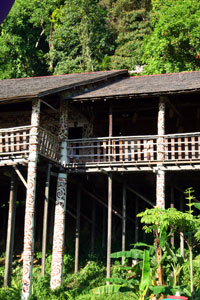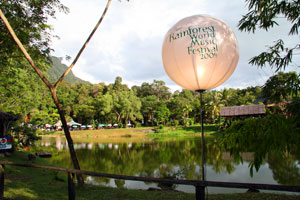“Sting and his friends sing with Brazilian stars at a pay-per-view rainforest benefit concert?”
This was my remark when asked if I’d heard of the Rainforest World Music Festival. I was pleased to be way off the mark. Some quick research revealed it was a three-day music festival held in Sarawak, the land of the hornbill. When asked if I wanted to go, my reply was, “Give me half an hour and I’ll be ready…”

Until recently, Borneo has been a place where people’s lives have been unchanged by the march of modernity. The numerous indigenous tribes have lived in harmony with the rainforest for centuries and it has in return provided them with food, shelter, clothing and materials used to make their unique musical instruments. One of these, the sape, a large stringed instrument, attracted the attention of Canadian Randy Raine-Reusch, a musician and student of ethnic music.
In 1998 the inaugural Rainforest World Music Festival was born, largely credited to his energetic efforts. Randy is still the creative director, helping to make sure the festival stays true to its original aim, to introduce the indigenous music of Borneo to a wider audience while inviting musicians from all corners of the earth to share the RWMF’s vision to celebrate the eternal musical spirit of humankind.
The Sarawak Cultural Village
RWMF is nothing like the big urban pop music festivals to which we have grown accustomed; the event celebrates the music rather than the celebrity, but the real star of the show is the spectacular venue, the Sarawak Cultural Village. On the other 362 days of the year, the village, set deep in lush rainforest, displays faithful reproductions of traditional tribal dwellings surrounding a small pond.

When we arrived in Kuching, we could feel the buzz in the city. We didn’t know what to expect, but my heart was already feeling the beat and the anticipation was heightened during the 45-minute drive into the jungle, back to the beginning.
We passed lush hills that dazzled in the early afternoon sunlight and, when the road started getting crowded with parked cars and groups of flip-flopped people walking on the side of the road, we knew we were close.
At the main entrance, I noticed our fellow festival-goers. As expected, there were many locals and backpackers, but the appearance of others suggested ethnomusicologists, members of the local business community, international school students from Kuala Lumpur and overseas teachers on sabbatical with their families.
After entering the grounds, we saw the scope of the breathtaking 17-acre site spread out before us. The rest of the afternoon was spent strolling around the venue, taking in workshops and marveling at Sarawak’s ethnic history and habitat.
As the sun set, we could hear the first band tuning up. We’d been lulled into a state of contentment as we ambled over to the main stage area. Here sedation was replaced by adrenaline.
The main stage, which blended into the tall trees during the day, was now dramatically lit from underneath, exaggerating the imposing scale. Rising almost 10 meters above the crowd, the artists appeared to be performing in the treetop canopy backlit by the stars. What theater.
World Music
Genuinely passionate musicians in this amazing setting is like an exotic dish thoughtfully prepared and artfully presented. Naturally, the music is the focal point; however, the setting enhances and electrifies the vibe to a level that even the most jaded can’t help but dance.

Past performances have included Tuvan throat singing, Afro-Caribbean rhythms, English “skiffle,” native Andean songs, Celtic ensembles, gamelan, Maori dancers, African drumming and on and on.
All of the artists performing also collaborate during the day to host music workshops, providing a chance to experience musical styles which otherwise would not be heard together. This up-close look at the performers speaking to each other in the common language of music was, for me, the highlight of the event.
This incredible experience reinforced my belief that music is a deeply communal human experience meant to be shared, and even the rainforest contributed with its symphony of running water, croaking frogs and the chorus of birds and wildlife in the trees.
Over the three-day festival, we reveled in the music from Sarawak, Korea, Poland, Indonesia, Finland, Tanzania, New Zealand, Chile, the United States, Morocco and Hungary.
The good-natured crowd, young and old, expressed a collective appreciation for the musicians, especially during the finale when all the performers gathered on stage for a final collaboration, treating us to the of true definition of “world music.”




